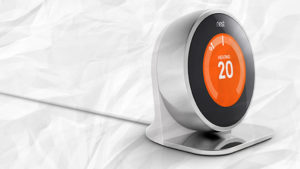WHAT IS THE NEST SMART THERMOSTAT?
By now you surely know the answer. The Nest thermostat is the flagship product from smart home / Internet of Things manufacturer Nest, the home automation company bought by Google in January for $3bn. It joins the company’s excellent Nest Protect smart smoke alarm and reaches the UK more than one year after it first launched in the US. But don’t fret, the Nest thermostat is now in its second major iteration and UK owners will benefit from that.

NEST – DESIGN AND FEATURES
Nest co-founder Tony Fadell was famously dubbed the ‘father of the iPod’ during his time at Apple and his eye for design is central to the Nest thermostat’s appeal. In short, this is by far the most attractive and best built smart thermostat we have seen and it oozes style and premium build quality.
The centrepiece is the thermostat itself: a stubby, cylindrical aluminium unit with razor sharp colour display. It has been at the heart of all Nest’s advertising and with good reason. The machined finish is flawless and the aluminium chassis rotates for menu navigation (more of later) and manual temperature adjustment using a weighty, clicker motion that makes you want to needlessly adjust it. The Apple DNA is strong.
But there is substance beneath the style. This second generation cuts the depth of the thermostat almost in half, yet it still houses the thermostat, a proximity sensor and two wireless receivers.
This is crucial to the Nest’s appeal. The first wireless receiver uses a proprietary low-band wireless frequency to connect to the ‘Heat Link’ — a second bundled device that replaces your current physical wall thermostat and communicates directly with the boiler.

Meanwhile, Nest’s second wireless receiver is standard 802.11n WiFi as it connects directly to your router. This means, unlike every other solution on the market, there is no need for a third bundled device — the dedicated Internet gateway — which clutters things up and requires another power socket.
The downside to squashing everything inside the thermostat is it does need a constant source of power, but it can still be either wall mounted (with wires channelled) or there is an attractive £29 stand that can be bought separately.
That may mean extra hassle and expense, but we’d rather have two units than the usual three seen in every other smart thermostat setup to date and it allows the Nest to cram in more functionality than almost any of its rivals.

















